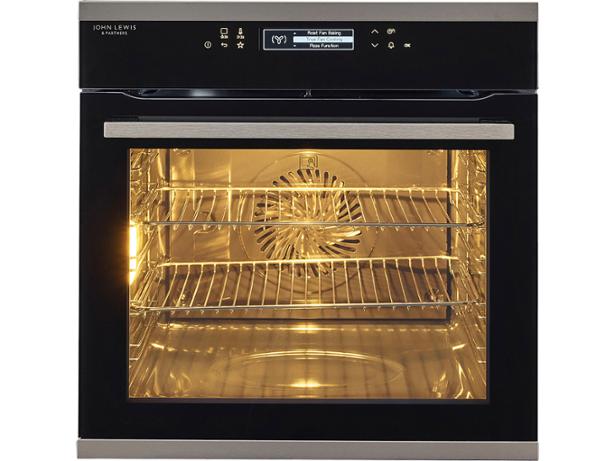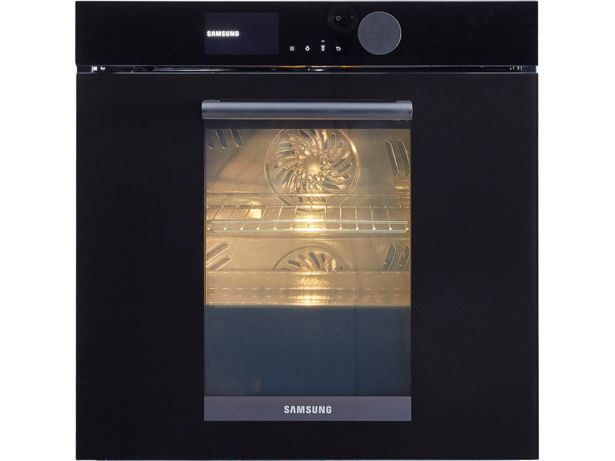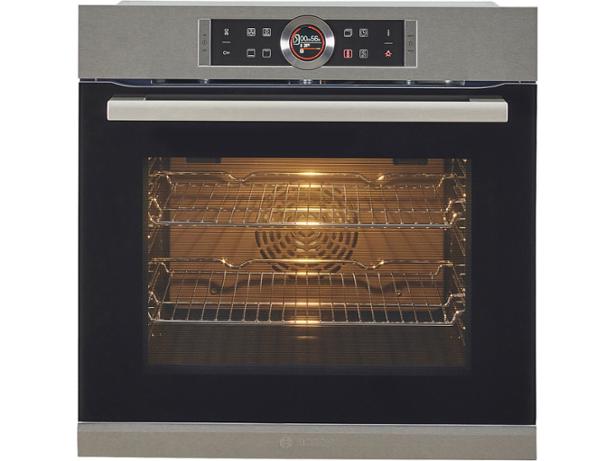How we test built-in ovens

We test more than 50 built-in ovens each year – single ovens, double ovens, electric and gas. From temperature accuracy to energy efficiency, our rigorous tests help Which? members to spend their money wisely.
Unlike free-to-access websites, which typically get the ovens they review free of charge directly from manufacturers or their PR representatives, we buy all the appliances we test ourselves so you can have complete trust in our verdict.
As well as using multiple testers in a lab-based scenario, the Which? overall percentage score is calculated purely on the measurements and ratings supplied by our lab, meaning there's no room for unconscious bias when giving an overall rating.
See all our best built-in ovens.
Video: how we test built-in ovens
Watch our video to learn more about how our labs test to find the best.
What are Which? Best Buy, Don’t Buy, Eco Buy and Great Value built-in ovens?

A quick guide to the recommendations you'll see on our reviews.
Best Buy ovens
Best Buys are given to ovens that impress the most in our tests. Single ovens that score 78% or more and double ovens that score 74% or more are Best Buys and come with a firm overall recommendation, although you should still read our reviews to check for any weaknesses that might impact your buying decision.
Best Buy ovens typically tick the most important boxes – they are quick to heat up, stick closely to the correct temperature and spread heat evenly throughout the whole oven cavity.
Don't Buy ovens
Ovens that score 45% or below are Don’t Buys.
Don't Buy ovens fall down in important areas – they may take an age to heat up, and even then veer far away from the temperature you think they are at.
Great Value ovens
If you're looking to keep costs down, our Great Value recommendations are for you.
Great Value ovens are at least 20% cheaper than the average price of the ovens we've tested and do pretty well in our tests, scoring 70% or more.
Some Great Value ovens also score highly enough to be Best Buys.
Eco Buy ovens
Eco Buy ovens are the most energy-efficient models we discover in our tests. They all come from brands that have a decent reliability record. They also score highly in our cooking tests.
An Eco Buy oven is therefore a great choice if you want to go for a sustainable option.
Here’s the criteria an oven must match if it’s to be an Eco Buy:
- A total test score of at least 70% for single ovens, or 65% for double ovens
- Four or five stars for energy efficiency
- Five stars for heat distribution (the most important aspect of performance)
- The brand must get a good longevity rating in our annual consumer survey
- Around 10% of our ovens are sustainable enough to be Eco Buys
Browse all our built-in oven reviews to see our recommendations in action.
How is the Which? score calculated?
The Which? overall score is a percentage. This score only takes into account the results of our tests and ignores price completely.
This means that all ovens are tested on exactly the same scale, so you can compare any oven at any price and know how it measures up against its rivals in key areas.
Weightings and star ratings
A Which? overall score is made up of dozens of individual tests and checks, from key factors such as speed of heating up, temperature accuracy and heat distribution to ease of use and what the grill is like. Behind each of those ratings could be more than 20 individual tests and checks. This means that the most important things – such as how accurately the oven maintains the correct temperature and distributes heat – will more greatly impact an oven’s score than whether or not the oven has loads of automatic programs.
To keep things simple, the most important scores are shown as star ratings out of five on each oven’s Test Results section as an easy-to-compare list of strengths and weaknesses, so you can quickly work out whether an oven is right for you.
How the overall oven test score is calculated
- Heat supply and distribution - 20%
- Thermostat accuracy - 20%
- Oven heat-up time - 10%
- Grill - 20%
- Ease of use - 17%
- Ease of cleaning - 8%
- Energy use - 5%
Our key testing criteria
Below are the key built-in oven testing categories and how we evaluate each one:
Heat distribution
Key question: Will the heat spread evenly and consistently throughout the oven?
We use baking trays covered with strips of shortbread to reveal just how effective ovens are at spreading heat right around the oven. The colour of the shortbread after cooking shows how evenly the oven distributes heat across each oven tray. The best ovens we’ve tested deliver heat evenly across the shortbread, but the worst leave the middles unbrowned and the corners burnt.
We also bake a large sponge cake in each oven and measure how well and evenly the cake rises, and how evenly the cake is browned.
Oven heat distribution and consistency makes up 20% of the score for an oven.
Temperature accuracy
Key question: Will this oven accurately remain at the correct temperature?
We record how accurately an oven sticks to the temperature it says it's at. Best Buys stay very close to the set temperatures, but the least accurate ovens can overheat by more than 30°C. This is enough to result in burnt food.
Oven accuracy makes up 20% of the score for an oven.Speed of heating up
Key question: How quickly will this oven heat up?
We set each oven to heat to high and low temperatures, and we record how long they take to reach these targets. Heat settings for conventional electric and gas ovens are 180°C (gas mark 4) and 200°C (gas mark 6). For fan-assisted electric ovens, the settings are 150°C and 180°C.
The best ovens take less than five minutes to heat up to 180°C, while the poorest ones will keep you waiting for nearly three times as long.
Speed of heating up makes up 10% of the score for an oven.Effectiveness of the grill
Key question: How effective is the grill part of this oven?
We cover each grill pan in white crustless bread to see how well, how far and how evenly the heat spreads. The best grills we’ve tested can effectively heat more than 90% of the grill pan.
The worst will struggle to heat anything more than the area directly beneath the element, or around 40%. This will leave you having to shuffle food around to get it evenly browned.
Grill performance makes up 20% of the score for an oven.
Ease of use
Key question: Is it easy to use the main features of this oven?
We use an independent panel to assess how easy each oven is to use. They look at how clear the markings are on the oven and how straightforward it is to operate the various settings. They load and unload the oven and grill, and assess how easy it is to check up on food while it is cooking.
Ease of use makes up 17% of the score for an oven.Ease of cleaning
Key questions: If the oven has a self-cleaning function, does it work well? If it doesn’t have one, how easy is it to keep clean manually?
Cleaning an oven is nobody’s favourite task. At the lab, our testers carefully apply cooking grime to various parts of the oven, then turn up the temperature and bake it on. They then run any self-clean function, such as pyrolytic cleaning, and see how good the results are. They also clean each oven manually, to find out which ones take the least effort to keep spick and span.
Ease of cleaning makes up 8% of the score for an oven.Smart oven testing
We’ve recently introduced new tests to help you know whether a wi-fi-enabled and app-controlled oven you’re thinking of buying is safe, secure and of any practical benefit.
App usefulness
Key question: Is the related app useful?
We look at what cooking programs and settings on the oven are available via the app. For example, are you able to adjust both cooking temperature and cooking time? And can you turn the oven on or off remotely?
App safety
Key question: Are there any app safety issues?
We check if an app allows you to do things that could lead to a physical safety risk.
Turning on the oven when you’re outside of the house could be a safety issue if it was possible on an ad-hoc basis. But, rather like the delayed-start function on an oven, you need to set up the oven manually before you leave home.
Some apps allow the oven to come on while the door is open. We believe this to be a potential safety issue, and raise it with manufacturers if we find it. Fortunately, none that we’ve come across so far allow you to remotely activate the high-temperature pyrolytic cleaning program.
App security
Key question: Are there any app security issues?
If the app is not secure, it could provide hackers with a back door into your home wi-fi network. This could allow them to control your oven and other wi-fi-connected appliances, or gain access to your computer or tablet and hack into your personal accounts.
Read more in our guide to Security and smart devices: how to protect your home from hackers.
Pick the perfect oven with Which? reviews
The actual usable capacity of your oven can be different from what the manufacturer claims. We only measure the space that you will actually be able to use inside an oven.
We measure the internal width from side to side, and the depth from the inside of the door to the back of the oven. But we only measure the height from the top of the lowest shelf to 3cm below the top of the oven. We don’t include the space beneath the lowest shelf, which manufacturers often do.
Browse all our built-in oven reviews to find your perfect model.


